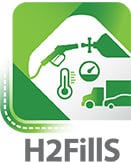H2FillS: Hydrogen Filling Simulation
The Hydrogen Filling Simulation (H2FillS) software is a thermodynamic model designed to track and report on the transient change in hydrogen temperature, pressure, and mass flow when filling a fuel cell electric vehicle (FCEV).

Capabilities
Use the comprehensive H2FillS model to:
- Safely design and operate a hydrogen fueling station
- Support code refinement with readily available data
- Develop system and operational improvements to reduce capital or operating costs at hydrogen stations or on-board FCEVs.
H2FillS Version 3
H2FillS Version 3 (partial station model) was released in October 2021 and includes the following upgrades:
- Enhanced computational speed
- Multi-parameter batch processing
- Pressure ramp rate optimization.
How It Works
H2FillS uses a "drag and drop" graphical user interface to simulate station and vehicle systems with preset parameters for common hydrogen station components as default values. When needed, users can define their own parameters to create their own station or vehicle components.
There are two versions of the model:
Download H2FillS in Two Steps
- Read the terms of the end user software license agreement.
- Register to download the software.
- A full-station model starts the simulation at high-pressure ground storage, runs through a dispenser, and ends at a vehicle storage system.
- A partial-station model starts at the dispenser breakaway and consists solely of the dispenser components and the vehicle storage system.
H2FillS will automatically output fill performance data from the vehicle by tracking pressure and temperature throughout the fill. Users can input their own fill profiles into the model to run a variety of simulations.
H2FillS User's Manual
How To Cite H2FillS
If you use H2FillS software for work described in a publication, please notify us and include a citation consistent with the following format:
Kuroki, T., K. Nagasawa, M. Peters, D. Leighton, J. Kurtz, N. Sakoda, M. Monde, and Y. Takata. 2021. "Thermodynamic Modeling of Hydrogen Fueling Process from High Pressure Storage Tanks to Vehicle Tank." International Journal of Hydrogen Energy 46(42): 22004–22017.
Acknowledgments
Institutional sponsors and an advisory council supported the development of H2FillS.
Sponsors
The U.S. Department of Energy was a sponsor along with the following industry and corporate sponsors:
- Ford Motor Company
- General Motors LLC
- Honda R&D Americas
- Hyundai-Kia America Technical Center
- Ivys Energy Solutions Inc.
- Shell
- Toyota.
Advisory Council
The advisory council includes Frontier Energy, which oversaw project management, along with a technical committee:
- Argonne National Laboratory
- Kyushu University
- Saga University
- Sandia National Laboratories
- Zero Carbon Energy Solutions Inc.
Contact
While NLR does not provide technical support for H2FillS.exe and/or H2FillS_Partial.exe, we welcome your feedback on the tool. To provide feedback or report any problems, contact [email protected].
Share
Last Updated Dec. 10, 2025
